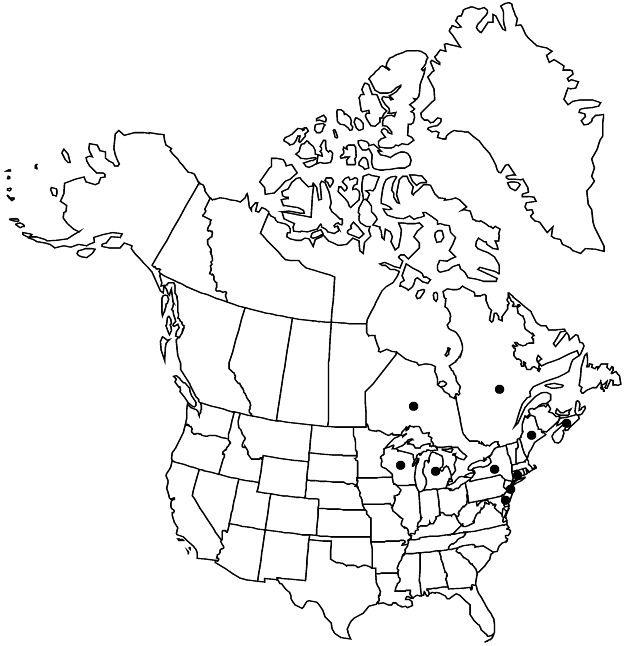Difference between revisions of "Aruncus dioicus var. vulgaris"
J. Jap. Bot. 30: 68. 1955.
FNA>Volume Importer |
imported>Volume Importer |
||
| (One intermediate revision by the same user not shown) | |||
| Line 37: | Line 37: | ||
|elevation=10–500 m | |elevation=10–500 m | ||
|distribution=N.S.;Ont.;Que.;Conn.;Del.;Maine;Mich.;N.J.;N.Y.;Wis.;c Europe;Asia (Caucasus). | |distribution=N.S.;Ont.;Que.;Conn.;Del.;Maine;Mich.;N.J.;N.Y.;Wis.;c Europe;Asia (Caucasus). | ||
| + | |introduced=true | ||
|discussion=<p>Variety vulgaris seems to be introduced and locally naturalized in the North America. The variety differs very little from <i></i>var.<i> acuminatus</i> and may prove to be identical. The longer follicles of <i></i>var.<i> acuminatus</i> seem to be the only difference, though H. Hara (1955) said that the petals of <i></i>var.<i> vulgaris</i> are larger than those of the other varieties. One may wonder whether this European-Asian taxon is a westward circum-Pacific extension of the American <i></i>var.<i> acuminatus</i>, or whether the latter is an eastward extension of <i></i>var.<i> vulgaris</i>. <i>Aruncus dioicus</i> in the broad sense displays the classic Arcto-Tertiary Mesoflora distribution pattern, and it is impossible to say where it originated, though the greatest diversity of varieties (ten) is in eastern Asia (Hara). The names A. aruncus (Linnaeus) H. Karsten and <i>A. vulgaris</i> Rafinesque are invalid and linked to this variety.</p> | |discussion=<p>Variety vulgaris seems to be introduced and locally naturalized in the North America. The variety differs very little from <i></i>var.<i> acuminatus</i> and may prove to be identical. The longer follicles of <i></i>var.<i> acuminatus</i> seem to be the only difference, though H. Hara (1955) said that the petals of <i></i>var.<i> vulgaris</i> are larger than those of the other varieties. One may wonder whether this European-Asian taxon is a westward circum-Pacific extension of the American <i></i>var.<i> acuminatus</i>, or whether the latter is an eastward extension of <i></i>var.<i> vulgaris</i>. <i>Aruncus dioicus</i> in the broad sense displays the classic Arcto-Tertiary Mesoflora distribution pattern, and it is impossible to say where it originated, though the greatest diversity of varieties (ten) is in eastern Asia (Hara). The names A. aruncus (Linnaeus) H. Karsten and <i>A. vulgaris</i> Rafinesque are invalid and linked to this variety.</p> | ||
|tables= | |tables= | ||
| Line 61: | Line 62: | ||
|publication year=1955 | |publication year=1955 | ||
|special status=Introduced | |special status=Introduced | ||
| − | |source xml=https:// | + | |source xml=https://bitbucket.org/aafc-mbb/fna-data-curation/src/2e0870ddd59836b60bcf96646a41e87ea5a5943a/coarse_grained_fna_xml/V9/V9_717.xml |
|subfamily=Rosaceae subfam. Amygdaloideae | |subfamily=Rosaceae subfam. Amygdaloideae | ||
|tribe=Rosaceae tribe Spiraeeae | |tribe=Rosaceae tribe Spiraeeae | ||
Latest revision as of 22:58, 5 November 2020
Leaf surfaces usually glabrous. Styles 0.3–0.5 mm. Follicles slender, 2.5–3 mm. Seeds 1.8–2.5 mm. 2n = 14, 18.
Phenology: Flowering summer.
Habitat: Rich woods
Elevation: 10–500 m
Distribution

Introduced; N.S., Ont., Que., Conn., Del., Maine, Mich., N.J., N.Y., Wis., c Europe, Asia (Caucasus).
Discussion
Variety vulgaris seems to be introduced and locally naturalized in the North America. The variety differs very little from var. acuminatus and may prove to be identical. The longer follicles of var. acuminatus seem to be the only difference, though H. Hara (1955) said that the petals of var. vulgaris are larger than those of the other varieties. One may wonder whether this European-Asian taxon is a westward circum-Pacific extension of the American var. acuminatus, or whether the latter is an eastward extension of var. vulgaris. Aruncus dioicus in the broad sense displays the classic Arcto-Tertiary Mesoflora distribution pattern, and it is impossible to say where it originated, though the greatest diversity of varieties (ten) is in eastern Asia (Hara). The names A. aruncus (Linnaeus) H. Karsten and A. vulgaris Rafinesque are invalid and linked to this variety.
Selected References
None.